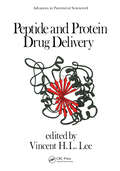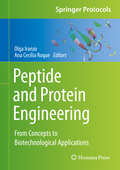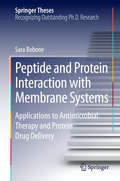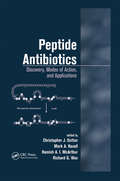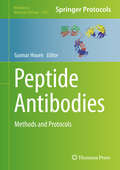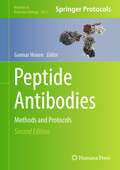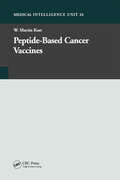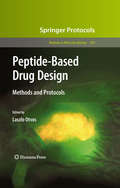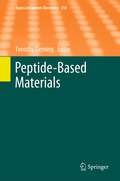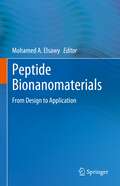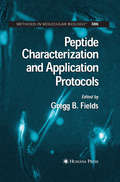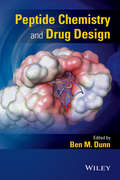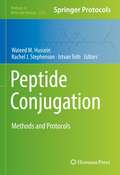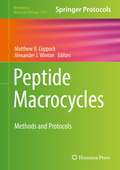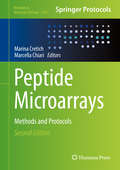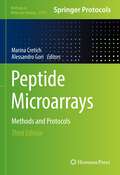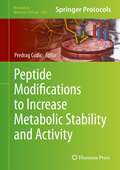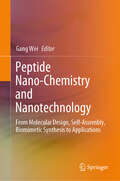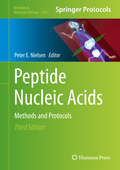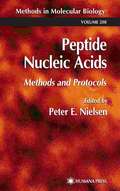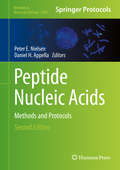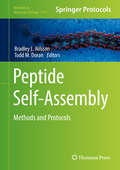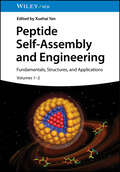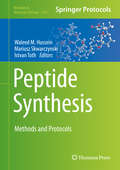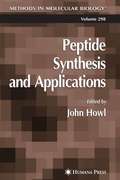- Table View
- List View
Peptide and Protein Drug Delivery (Advances in Parenteral Science)
by Lee, Vincent H. L.This reference/text covers fundamentals of peptide and protein drug delivery, including such considerations as synthesis, physical chemistry and biochemistry, analysis, proteolytic and transport constraints, pharmacokinetics, and pharmacodynamics; bioavailability from routes of administration, detai
Peptide and Protein Engineering: From Concepts to Biotechnological Applications (Springer Protocols Handbooks)
by Olga Iranzo Ana Cecília RoqueThis thorough book aims to present the methods that have enabled the success of peptides and proteins in a wide variety of applications. It opens with a section on chemical tools applied to the production or engineering of peptides and proteins, and concludes with a collection of chapters on biological approaches used to engineer structure and function in peptides and proteins. As a book in the Springer Protocols Handbooks series, chapters include the kind of detailed descriptions and tips necessary for successful results in practice. Authoritative and practical, Peptide and Protein Engineering: From Concepts to Biotechnological Applications will be of great use to scientists in academia and industry seeking a better understanding of the emerging principles and methodologies in peptide and protein engineering.
Peptide and Protein Interaction with Membrane Systems
by Sara BoboneIn her thesis, Sara Bobone outlines spectroscopic studies of antimicrobial peptides (AMPs) which are promising lead compounds for drugs used to fight multidrug resistant bacteria. Bobone shows that AMPs interact with liposomes and she clarifies the structure of pores formed by one of these molecules. These results help us to understand how AMPs are selective for bacterial membranes and how their activity can be finely tuned by modifying their sequence. Findings which solve several conundrums debated in the literature for years. In addition, Bobone uses liposomes as nanotemplates for the photopolymerization of hydrogels - exploiting the self- assembly properties of phospholipids. Bobone was able to trap an enzyme using nanometeric particles, while still allowing its activity by the diffusion of substrates and products through the network of the polymer. The innovative nano devices described in this thesis could solve many of the hurdles still hampering the therapeutic application of protein-based drugs.
Peptide Antibiotics: Discovery Modes Of Action And Applications
by Christopher J. Dutton Mark A. Haxell Hamish A. I. McArthur Richard G. WaxThis reference summarizes the latest research on the structure, function, and design of synthetic and natural peptide antibiotics, describing practical applications of these compounds in food preservation and packaging, and in the prevention and treatment of infectious diseases by direct anti-bacterial action and as part of the adaptive immune resp
Peptide Antibodies
by Gunnar HouenThis extensive volume covers basic and advanced aspects of peptide antibody production, characterization and uses. Although peptide antibodies have been available for many years, they continue to be a field of active research and method development. For example, peptide antibodies which are dependent on specific posttranslational modifications are of great interest, such as phosphorylation, citrullination and others, while different forms of recombinant peptide antibodies are gaining interest, notably nanobodies, single chain antibodies, TCR-like antibodies, among others. Within this volume, those areas are covered, as well as several technical and scientific advances: solid phase peptide synthesis, peptide carrier conjugation and immunization, genomics, transcriptomics, proteomics and elucidation of the molecular basis of antigen presentation and recognition by dendritic cells, macrophages, B cells and T cells. Written in the highly successful Methods in Molecular Biology series format, chapters include introductions to their respective topics, lists of the necessary materials and reagents, step-by-step, readily reproducible laboratory protocols and tips on troubleshooting and avoiding known pitfalls. Comprehensive and authoritative, Peptide Antibodies: Methods and Protocols serves as an ideal reference for researchers exploring this vital and expansive area of study.
Peptide Antibodies: Methods and Protocols (Methods in Molecular Biology #2821)
by Gunnar HouenThis detailed new edition explores current methods for the production and use of peptide antibodies. The book delves into various aspects of peptide synthesis and analysis, peptide-carrier conjugation, epitope and paratope prediction and identification, as well as improved assays and other uses of peptide antibodies. Written for the highly successful Methods in Molecular Biology series, chapters include introductions to their respective chapters, lists of the necessary materials and reagents, step-by-step and readily reproducible laboratory protocols, and tips on troubleshooting and avoiding known pitfalls. Authoritative and up-to-date, Peptide Antibodies: Methods and Protocols, Second Edition serves as an ideal reference for researchers exploring this vital and expansive area of study.
Peptide-Based Cancer Vaccines
by W. Martin KastThe field of peptide based cancer vaccines has evolved tremendously in the last decade of this century. The exploration on how to apply the peptide knowledge for vaccination purposes began when it was demonstrated that these peptides after being mixed into adjuvants actually induced T cell responses that could prevent virus infections and tumor growth in experimental animal models. The results of animal models are currently translated into clinical applications with all their associated difficulties and heterogeneity. Initial promising data do appear, warranting further research in this area. This book pays tribute to key researchers in the field.
Peptide-Based Drug Design
by Laszlo OtvosDue to their high specificity and low toxicity profile, peptides have once again become central to the development of new drugs. In Peptide-Based Drug Design: Methods and Protocols, expert researchers provide a handbook which offers a selection of research and production tools suitable for transforming a promising protein fragment or stand-alone native peptide into a pharmaceutically acceptable composition. The volume delves into contemporary, cutting-edge subjects such as hit isolation and target validation, computer-aided design, sequence modifications to satisfy pharmacologists, in vivo stability and imaging, and the actual production of difficult sequences. Written in the highly successful Methods in Molecular BiologyTM series format, chapters include readily reproducible, step-by-step laboratory protocols, lists of materials, and the Notes section, which highlights tips on troubleshooting and avoiding known pitfalls. Comprehensive and up-to-date, Peptide-Based Drug Design: Methods and Protocols shows its subject to be an independent science on the rise, and provides scientists with a clear, concise guide for continuing this vital research.
Peptide-Based Materials
by Timothy DemingSynthesis of Polypeptides by Ring-Opening Polymerization of α-Amino Acid N-Carboxyanhydrides, by Jianjun Cheng and Timothy J. Deming.- Peptide Synthesis and Self-Assembly, by S. Maude, L. R. Tai, R. P. W. Davies, B. Liu, S. A. Harris, P. J. Kocienski and A. Aggeli.- Elastomeric Polypeptides, by Mark B. van Eldijk, Christopher L. McGann, Kristi L. Kiick andJan C. M. van Hest.- Self-Assembled Polypeptide and Polypeptide Hybrid Vesicles: From Synthesis to Application, by Uh-Joo Choe, Victor Z. Sun, James-Kevin Y. Tan and Daniel T. Kamei.- Peptide-Based and Polypeptide-Based Hydrogels for Drug Delivery and Tissue Engineering, by Aysegul Altunbas and Darrin J. Pochan.-
Peptide Bionanomaterials: From Design to Application
by Mohamed A. ElsawyMolecular self-assembly has been exploited by nature for developing the higher functional macromolecular structures of both the genome and proteome. Inspired by nature, there has been a surge of research, in the last two decades, for the molecular engineering of peptide-based self-assembling nanostructures, adopting the bottom-up design approach. This book gives the reader an overview on the design rules for de novo self-assembling peptide and reviews the diverse range of bioinspired peptide nanostructures such as β-sheet and β-hairpin, α-helical and coiled coil, self-assembling short peptides and peptidomimetics, collagen-based and elastin-like peptides, silk peptides, peptide amphiphiles, peptides co-polymers and others. The book also covers the wide variety of responsive and functional biomaterials that have been innovated based on those nanostructures for various applications ranging from tissue engineering, therapeutics and drug delivery to antimicrobial nanomaterials and biosensors. Finally, the book also discusses the peptide bionanomaterials global market and the future of the emerging industry.Chapter “Characterization of Peptide-Based Nanomaterials” is available open access under a Creative Commons Attribution 4.0 International License via link.springer.com.
Peptide Characterization and Application Protocols
by Gregg B. FieldsThis book is dedicated to the characterization of peptides and their applications for the study of biochemical systems. The contributing authors are all leaders in the field of peptide research. Part I, Characterization, presents the most recent advances in select analytical techniques. Part II, Application, presents a variety of specific applications for synthetic peptides. This book is an indispensable aid in the pursuit of new directions in peptide research.
Peptide Chemistry and Drug Design
by Ben M. DunnThis book focuses on peptides as drugs, a growing area of pharmaceutical research and development. It helps readers solve problems of discovering, developing, producing, and delivering peptide-based drugs. * Identifies promising new areas in peptide drug discovery * Includes chapters on discovery from natural sources, metabolic modification, and drug delivery * Overviews separation methods and techniques for analysis, bond formation, and purification * Offers readers both a professional reference and a text or resource for graduate-level students
Peptide Conjugation: Methods and Protocols (Methods in Molecular Biology #2355)
by Waleed M. Hussein Rachel J. Stephenson Istvan TothThis volume explores diverse protocols for peptide conjugation, and provides thoroughly tested and scientifically valid techniques that allow researchers and scientists to prepare, purify, characterize, and use peptide conjugation methods for chemical, biochemical, and biological studies. Some of the topics discussed in this book are gold nanoparticles, proteins, pegylated lipids, and vitamins. Chapters also cover enzymatic ligation using sortase A, construction of a phage-displayed cyclic-peptide library, quantum dot-peptide conjugates, and preparation of lipopeptides by CLipPA chemistry. Written in the highly successful Methods in Molecular Biology series format, chapters include introductions to their respective topics, lists of the necessary materials and reagents, step-by-step, readily reproducible laboratory protocols, and tips on troubleshooting and avoiding known pitfalls. Cutting-edge and comprehensive, Peptide Conjugation: Methods and Protocols is a valuable resource for experienced researches and undergraduate students alike who are interested in learning more about this exciting and developing field.
Peptide Macrocycles: Methods and Protocols (Methods in Molecular Biology #2371)
by Matthew B. Coppock Alexander J. WintonThis volume explores the latest techniques and strategies used to study the field of peptide macrocycles. The chapters in this book ae organized into four parts: macrocycles synthesis, combinational library synthesis and screening, macrocycle characterization, and unique applications. Part One looks at a variety of peptide cyclization methodologies, and Part Two describes methods for the creation of peptide macrocycles libraries and their subsequent screening against biological targets of interest. Part Three discusses the study and characterization of peptide macrocycle-target interactions, and Part Four introduces unique applications for peptide macrocycles, from higher-order structure formation to post-synthetic functional modifications. Written in the highly successful Methods in Molecular Biology series format, chapters include introductions to their respective topics, lists of the necessary materials and reagents, step-by-step, readily reproducible laboratory protocols, and tips on troubleshooting and avoiding known pitfalls. Cutting-edge and comprehensive, Peptide Macrocycles: Methods and Protocols is a valuable resource for both novice and expert researchers looking to learn more about this developing field.
Peptide Microarrays
by Marina Cretich Marcella ChiariDue to their versatility, along with the diminishing costs of library synthesis and the growth of commercial support, peptide microarrays will likely expand beyond being just a research tool into an adaptable and powerful platform to be harnessed for wider drug discovery and point-of-care applications. In Peptide Microarrays: Methods and Protocols, experts in the field provide a cutting-edge view of peptide array technology, its applications, and technical issues. After examining how peptides can characterize proteins and clarify, at the amino acid level, the molecular recognition events in which they are involved, the volume goes on to cover topics such as the production and use of peptide arrays for enzyme and binding motifs characterization, epitope mapping, and diagnostics, the newest technological advancements, as well as software and web tools for the design of peptide arrays and for the analysis of output data. As a volume in the highly successful Methods in Molecular BiologyTM series, chapters include brief introductions to their respective topics, lists of the necessary materials and reagents, step-by-step, readily reproducible laboratory protocols, and notes on troubleshooting and avoiding known pitfalls. Authoritative and easy-to-use, Peptide Microarrays: Methods and Protocols promises to serve scientists with its unique insights and novel solutions in peptide array technology in order to advance this vital field.
Peptide Microarrays: Methods and Protocols (Methods in Molecular Biology #2578)
by Marina Cretich Alessandro GoriThis detailed volume provides an updated overview of current uses of peptide microarray technology, showcasing consolidated applications while highlighting some of the most intriguing novelties and emerging fields of use. The methodologies within this collection are of considerable value for both advanced users and new-comers in the peptide microarray arena, as the renowned contributors describe full coverage of the aspects related to their workflows, from microchip manufacturing to advanced analytical applications. Written for the highly successful Methods in Molecular Biology series, chapters include introductions to their respective topics, lists of the necessary materials and reagents, step-by-step and readily reproducible laboratory protocols, and tips on troubleshooting and avoiding known pitfalls. Authoritative and up-to-date, Peptide Microarrays: Methods and Protocols, Third Edition aims to make the use of peptide microarrays more and more accessible while stimulating further developments to sustain exciting discoveries in the biochemistry and medicine realms.
Peptide Modifications to Increase Metabolic Stability and Activity
by Predrag CudicIn Peptide Modifications to Increase Metabolic Stability and Activity, expert researchers in the field provide summarized methods for preparation, purification of modified peptides, and assessment of their biochemical activities. These methods and protocols include preparation of conformationally constrained peptides, modification of peptide bonds, introduction of nonproteinogenic amino acids, and alteration of peptides' physical and biological properties by modification of the amino acid side chains and/or terminal residues. With additional chapter that describes new experimental approach for the detection of exogenous peptides within living cells using peptides labeled with heavy isotopes and confocal Raman microscopy. Written in the highly successful Methods in Molecular Biology series format, chapters include introductions to their respective topics, lists of the necessary materials and reagents, step-by-step, readily reproducible laboratory protocols, and tips on troubleshooting and avoiding known pitfalls. Authoritative and practical, Peptide Modifications to Increase Metabolic Stability and Activity seeks to provide scientists with alternative approaches to peptide modification that many researchers may find applicable to their specific research requirements.
Peptide Nano-Chemistry and Nanotechnology: From Molecular Design, Self-Assembly, Biomimetic Synthesis to Applications
by Gang WeiThis book presents the progress in functional peptides in the fields of nano-chemistry and nanotechnology. It covers the synthesis and properties of peptides, functionalization and hybridization of peptides, and applications of peptide-based nanomaterials. The first section provides an overview of the self-assembly of designed peptides to 1D, 2D, and 3D nanostructures. This is followed by the introduction of the hybridization of peptides with polymers, nanoparticles, carbon materials, and 2D materials through specific binding and biomimetic synthesis to create bioactive nanomaterials. Finally, the book highlights the applications of peptide-based nanomaterials in materials science, nanotechnology, and biomedicine. This book helps readers to understand the chemical, physical, and biological properties of peptides and further inspire the design and synthesis of functional peptide nanomaterials for advanced applications.
Peptide Nucleic Acids: Methods and Protocols (Methods in Molecular Biology #2105)
by Peter E. NielsenThis third volume exemplifies and illustrates exciting advances in peptide nucleic acids (PNA) chemistry, and serves as a vital complement to the first and second edition of the book. Chapters focus on in vivo properties and behavior and applications of PNA while providing contributions on both chemistry and nucleic acid recognition. Written in the highly successful Methods in Molecular Biology series format, chapters include introductions to their respective topics, lists of the necessary materials and reagents, step-by-step, readily reproducible laboratory protocols, and tips on troubleshooting and avoiding known pitfalls. Authoritative and cutting-edge, Peptide Nucleic Acid: Methods and Protocols, Third Edition aims to ensure successful results in the further study of this vital field.
Peptide Nucleic Acids
by Peter E. NielsenPeter Eigil Nielsen has assembled a critically evaluated collection of key PNA protocols that are either already well established around the world, such as PCR-clamping and in situ hybridization, or that display promise of significant future impact. Basic methods for PNA oligomer synthesis and analysis have also been included. Written by experts with hands-on in the methods they describe, these readily reproducible protocols contain detailed step-by-step instructions, tips on avoiding pitfalls and on extending the method to other situations, and introductory material explaining the theory behind the process.
Peptide Nucleic Acids
by Peter E. Nielsen Daniel H. AppellaPeptide nucleic acids (PNAs) have now existed for slightly more than ten years, with the interest in and applications of this pseudopeptide DNA mimic steadily increasing during the entire period. PNAs have rapidly attracted the attention of scientists from a diversity of fields ranging from (bio)organic and biophysical chemistry to prebiotic evolution, and from molecular biology to genetic diagnostics and drug development. Many of the applications take advantage of the unique properties of PNA--an uncharged pseudopeptide--that distinguish this DNA mimic from more traditional DNA analogs. Rather than trying to create a comprehensive collection of all published methods and protocols involving PNA--many of which have not yet been validated-- I have decided to concentrate on select protocols that are either very well established by several groups around the world, such as PCR-clamping and in situ hybridization, or on new methods that may have broader future impact. Basic methods for PNA oligomer synthesis and analyses have also been included. I am very grateful to those friends and colleagues who have enthusiastically contributed their work, discussions, and writing, and thereby made this book possible. Peter E. Nielsen v Contents Preface. . . . . . . . . . . . . . . . . . . . . . . . . . . . . . . . . . . . . . . . . . . . . . . . . . . . . . . . . . . . . . . . . . . . . . . . . . . . . . . . . v Contributors. . . . . . . . . . . . . . . . . . . . . . . . . . . . . . . . . . . . . . . . . . . . . . . . . . . . . . . . . . . . . . . . . . . . . . . . . ix IINTRODUCTION 1 PNA Technology Peter E. Nielsen. . . . . . . . . . . . . . . . . . . . . . . . . . . . . . . . . . . . . . . . . . . . . . . . . . . . . . . . . . . . . . . . . . 3 II CHEMISTRY 2 Solid Phase Synthesis of PNA Oligomers Frederik Beck. . . . . . . . . . . . . . . . . . . . . . . . . . . . . . . . . . . . . . . . . . . . . . . . . . . . . . . . . . . . . . . . . . . 29 3 Synthesis of PNA-Peptide Conjugates Satish Kumar Awasthi and Peter E. Nielsen. . . . . . . . . . . . . . . . . . 43 4 Parallel Synthesis of PNA-Peptide Conjugate Libraries Satish Kumar Awasthi and Peter E. Nielsen. . . . . . . . . . . . . . . . . .
Peptide Self-Assembly: Methods and Protocols (Methods in Molecular Biology #1777)
by Todd M. Doran Bradley L. NilssonThis volume details methods and protocols on b-sheet assemblies and collagen. Divided into three parts chapters focus on expanding use of solid-state NMR as a powerful method to enhance structural understanding of self-assembled peptide materials, methods for the design, synthesis, and application of self-assembled peptide materials, and structural and mechanistic analyses of pathological amyloid systems that provide novel ways to assess function of the various possible aggregates as well to determine how the structure of these materials correlates to function/dysfunction in the biological context. Written in the highly successful Methods in Molecular Biology series format, chapters include introductions to their respective topics, lists of the necessary materials and reagents, step-by-step, readily reproducible laboratory protocols, and tips on troubleshooting and avoiding known pitfalls.Authoritative and cutting-edge, Peptide Self-Assembly: Methods and Protocols aims to capture modern methods that span the breadth of the exciting and expanding field of peptide self-assembly.
Peptide Self-Assembly and Engineering: Fundamentals, Structures, and Applications
by Xuehai YanPeptide Self-Assembly and Engineering State-of-the-art research in peptide self-assembly, with coverage of fundamental aspects of how peptides self-assemble and an extensive number of applications Peptide Self-Assembly and Engineering: Fundamentals, Structures, and Applications (2V set) covers the latest progresses in the field of peptide self-assembly and engineering, including the fundamental principles of peptide self-assembly, new theory of nucleation and growth, thermodynamics and kinetics, materials design rules, and precisely controlled structures and unique functions. The broad contents from this book enable readers to obtain a systematical and comprehensive knowledge in the field of peptide self-assembly and engineering. Contributed by the leading scientists and edited by a highly qualified academic and an authority in the field, Peptide Self-Assembly and Engineering includes information on: Emerging areas in peptide assembly, such as immune agents, bioelectronics, energy conversion, flexible sensors, biomimetic catalysis, and more Existing applications in biomedical engineering, nanotechnology, and photoelectronics, including tissue engineering, drug delivery, and biosensing devices History of peptide self-assembly for design of functional materials and peptides’ unique mechanical, optical, electronic, and biological properties Various solvent conditions, such as pH, ionic strength, and polarity, that can affect the structure and stability of peptide assemblies A very comprehensive reference covering the latest progresses in the field of peptide self-assembly and engineering, Peptide Self-Assembly and Engineering is an essential resource for all scientists performing research intersecting with the subject, including biochemists, biotechnologists, pharmaceutical chemists, protein chemists, materials scientists, and medicinal chemists.
Peptide Synthesis: Methods and Protocols (Methods in Molecular Biology #2103)
by Waleed M. Hussein Mariusz Skwarczynski Istvan TothThis book provides a variety of procedures for synthetically producing peptides and their derivatives, ensuring the kind of precision that is of paramount importance for successful synthesis. Numerous techniques relevant to drugs and vaccines are explored, such as conjugation and condensation methodologies. Written for the highly successful Methods in Molecular Biology series, chapters include introductions to their respective topics, lists of the necessary materials and reagents, step-by-step, readily reproducible laboratory protocols, and tips on troubleshooting and avoiding known pitfalls. Authoritative and practical, Peptide Synthesis: Methods and Protocols serves as an essential guide to the many crucial processes that will allow researchers to efficiently prepare, purify, characterize, and use peptides for chemical, biochemical, and biological studies.
Peptide Synthesis and Applications
by John HowlHands-on experts describe in step-by-step detail the key methodologies of contemporary peptide synthesis and illustrate their numerous applications. The techniques presented include protocols for chemical ligation, the synthesis of cyclic and phosphotyrosine-containing peptides, lipoamino acid- and sugar-conjugated peptides, and peptide purification and analyses. Additional chapters detail methodologies and instrumentation for high-throughput peptide synthesis, many different applications of peptides as novel research tools and biological probes, and the design and application of fluorescent substrate-based peptides that can be used to determine the selectivity and activity of peptidases. A practical guide to the identification of proteins using mass spectrometric analyses of peptide mixtures is also included.
